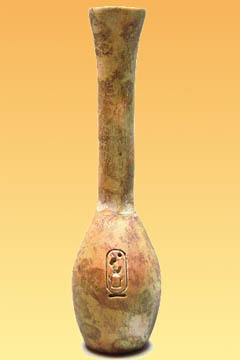Hatshepsut's Perfume
Experts in Germany are examining an alabaster container on which is carved the name of Hatshepsut, the Eighteenth Dynasty queen who ruled as a pharaoh in her own right. Although an interesting object in its own right - the 4.7" high bottle looks like the perfume containers which appear in some tomb paintings - the excitement comes from the fact that computer tomography has identified a residue in the interior of the container. According to Michael Hoveler-Muller, curator of the Bonn University Egyptian Museum, "I was looking for the perfume residue, because I had one good hint - the form of the bottle is a well-known perfume bottle, which was originally closed."
|
| A perfume bottle bearing the name of Queen Hatshepsut |
Using modern technology it is possible to identify the contents of this residue, but chemical analysis can only tell you that there are atoms of carbon or zince or whatever in the brew. The difficulty is going to be deciding what natural ingredients might produce such a mix of elements.
Of course we have a clue in Hatshepsut's famous mortuary temple of Deir el-Bahri, where one gallery contains an extensive series of reliefs depicting a voyage to Punt. Based on the vegetation and animal life visible in the reliefs, as well as the facial features of the natives depicted, most archaeologists believe that Punt was somewhere in modern Somalia. The products obtained by Hatshepsut's expedition included myrrh, frankincense and incense trees, which rather points to southern Saudi Arabia rather than Somalia - though it is possible that vegatation of Somalia has changed along with the climate.
Just outside the entrance to Deir el-Bahri are two pits cut in the bedrock in which are battered stumps of trees. Many visitors fail to notice them, but in fact they are the remains of the extensive gardens that once stood in and around the temple. More than 60 pits filled with Nile mud have been found in the area leading up to the temple, along with indications of an irrigation system and two T-shaped pools.
Naville, who discovered the two stumps, identified them as persea trees, which is interesting because persea require continuously moist soil. Given the location we have to conclude that in ancient times there were continuous convoys of donkeys laden with water jars toiling up the slope from the Nile. However Winlock, who re-examined them after the First World War, demonstrated that the stumps of today were not the original trees but replacements planted much later. It is reasonable to assume that they replaced trees of the same kind, but that is not certain and because Hatshepsut boasts of planting frankincense trees around her temple it is possible that the original plants were the fabled frankincense.
However Hatshepsut's perfume may have contained other ingredients: local blossoms, fruit, honey, aromatic wood were all used to make perfume, along with various oils or fats. Pictures of feasts commonly show Egyptian women with cones of perfume on their heads; the suggestion is that these were made of scented fat which slowly melted with the wearer's body heat, releasing the scent - a truly horrible thought, for the women all wore heavy wigs and the only fat available was butter or animal fat. I doubt that many modern socialites would wish to have a lump of lard on their heads, slowly melting and running down their necks.
If the boffins are able to identify the substances in Hatshepsut's perfume the next step would be to recreate it. Given that tastes in perfume vary wildly between cultures and even over time, it is unlikely that modern noses will be ravished by the ancient queen's scent, but I have no doubt that a modified version will shortly be on sale in the Bonn Museum - to be followed even more shortly by totally dissimilar liquids touted as "Hatshepsut's Perfume" in the multitudinous "perfume factories" that form an essential part of any tour of Egypt. I'm not sure whether to say "Ladies, beware" - you'll be wearing the stuff - or "Gentlemen, beware" - you'll be paying for it.
T-shaped pools Considering their position in the garden most people would think that the pools were intended to hold water for irrigation or provided a pleasant water feature in the garden. The fact that the pools were filled with dried Nile mud and contained cut papyrus stalks and a piece of an Egyptian boomerang clearly indicate that they were attractive features stocked with both plant and birdlife. However the T-shape has led some to suggest that they were intended to represent a canal ending in a harbour.
The pyramids were served by just such installations which served to transport building stone and also the pharaoh's body. If this suggestion is correct, then the ramps which are such a feature of Deir el-Bahri are analogous to the causeways that ran from the Valley Temple to the Mortuary Temple of nearly every pyramid. Return
© Kendall K. Down 2009






